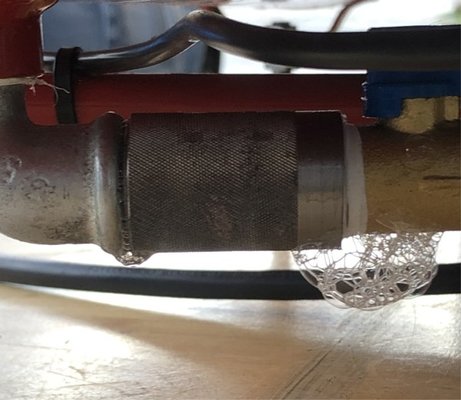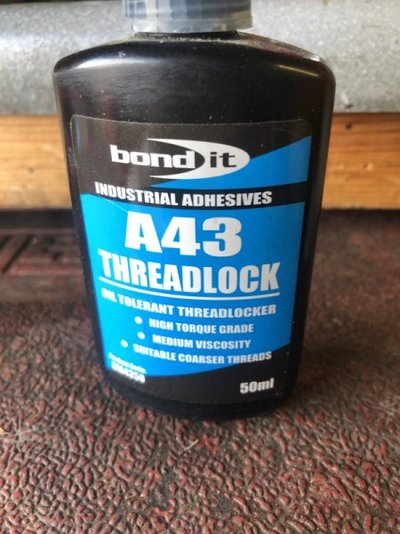You are using an out of date browser. It may not display this or other websites correctly.
You should upgrade or use an alternative browser.
You should upgrade or use an alternative browser.
compressor auto drain conversion
- Thread starter T0rnado69
- Start date
timgunn1962
Member
- Messages
- 367
- Location
- Lancashire UK
Use a length of flexible tube between the elbow and the drain valve and mount the drain valve up and out of the way. Often the best place on a mobile compressor is on the side of the table-thing the pump and motor are mounted on.
With 100-150 PSI behind any condensate, the drain valve doesn't need to be at the low point. I generally like to put it somewhere it'll get seen and the test button will get pressed. Codgerhood means that ain't on the floor.
With stationary compressors, it's often on the wall. With mobile compressors, it's often on the side of the table-thing. With the mobiles, there's usually a long series of fittings needed to mount the valve to the bottom of the receiver, which makes for a long lever and is very prone to breaking when the compressor is moved.
With 100-150 PSI behind any condensate, the drain valve doesn't need to be at the low point. I generally like to put it somewhere it'll get seen and the test button will get pressed. Codgerhood means that ain't on the floor.
With stationary compressors, it's often on the wall. With mobile compressors, it's often on the side of the table-thing. With the mobiles, there's usually a long series of fittings needed to mount the valve to the bottom of the receiver, which makes for a long lever and is very prone to breaking when the compressor is moved.
T0rnado69
DIY nut !!
- Messages
- 1,901
- Location
- Essex
little update, had days where i couldn't do much due to heel pain,
and days where your on your feet for as long as you can take it.
so little spare time to get these jobs done,
anyway i managed to finish the 75mm long 3/8 to 1/2 adaptor for the comp...
not test fitted them all together yet to see if everything ends up the right way up..
ild had enough and my heels where screaming to sit down.
hopefully tomorrow i can test fit them all. and adjust if needed.
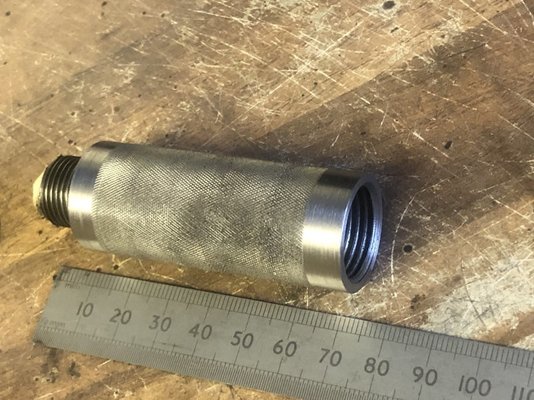
and days where your on your feet for as long as you can take it.
so little spare time to get these jobs done,
anyway i managed to finish the 75mm long 3/8 to 1/2 adaptor for the comp...
not test fitted them all together yet to see if everything ends up the right way up..
ild had enough and my heels where screaming to sit down.
hopefully tomorrow i can test fit them all. and adjust if needed.

Farside
Badly Welded Man
- Messages
- 6,390
- Location
- Ireland
Bloody good idea. I've never seen that done, yet it makes perfect sense. Any remaining condensate in the pipe is negligible compared to a tank that's been neglected and got lots in it.Use a length of flexible tube between the elbow and the drain valve and mount the drain valve up and out of the way. Often the best place on a mobile compressor is on the side of the table-thing the pump and motor are mounted on.
With 100-150 PSI behind any condensate, the drain valve doesn't need to be at the low point. I generally like to put it somewhere it'll get seen and the test button will get pressed. Codgerhood means that ain't on the floor.
With stationary compressors, it's often on the wall. With mobile compressors, it's often on the side of the table-thing. With the mobiles, there's usually a long series of fittings needed to mount the valve to the bottom of the receiver, which makes for a long lever and is very prone to breaking when the compressor is moved.
T0rnado69
DIY nut !!
- Messages
- 1,901
- Location
- Essex
another update.
the above adaptor turned out to be too long. so it all stuck out past the wheels.
didn't want it catching on anything, so i had to half it basically.
and re thread the 3/8 end.
its all fitted now and i powered the comp up for the first time today to 50psi
and then let it sit.
found a water trap and quick connector are leaking and not by the threaded joints.
but shut the gate valve off to stop the leak.
everything else seems to be air tight.
and the auto drain worked fine. kicking in and off again.
just need some new quick connectors and it will be done.
time for some online shopping
photos on next update.
the above adaptor turned out to be too long. so it all stuck out past the wheels.
didn't want it catching on anything, so i had to half it basically.
and re thread the 3/8 end.
its all fitted now and i powered the comp up for the first time today to 50psi
and then let it sit.
found a water trap and quick connector are leaking and not by the threaded joints.
but shut the gate valve off to stop the leak.
everything else seems to be air tight.
and the auto drain worked fine. kicking in and off again.
just need some new quick connectors and it will be done.
time for some online shopping

photos on next update.
I can't believe they charge 150 quid for a bit of brake pipe and a pneumatic solenoid.
If I was going to do it I would have it so when the pressure drops to pretty much zero It opens the drain. Teeing off the outlet. When you want to dump, you turn it off take the air out. Valve opens. Closes when you build up pressure. Just using a switching valve. No electrics involved
If I was going to do it I would have it so when the pressure drops to pretty much zero It opens the drain. Teeing off the outlet. When you want to dump, you turn it off take the air out. Valve opens. Closes when you build up pressure. Just using a switching valve. No electrics involved
T0rnado69
DIY nut !!
- Messages
- 1,901
- Location
- Essex
another update.
so the quick connectors arrived.
1/2bsp male, 3/8 bsp male
took the gate valve and water trap off the 1/2 elbow on tank right side.
the gate valve went from 1/2bsp to 1/4bsp and as that hose goes to a quick connector near the lathe for a air line
and thru the wall to a regulator/water trap for the shotblast cabinet.
i thought it best to do away with the 1/4 valve and water trap, and keep it as big bore as poss...
so now 1/2bsp elbow to a 1/2bsp male quick connector.
on the left side i changed the 3/8 elbow to a 3/8 tee.
to put an extra 3/8 male quick connector on that side.
so i can run a hose to a regulator on the left side for the plasma to be connected too.
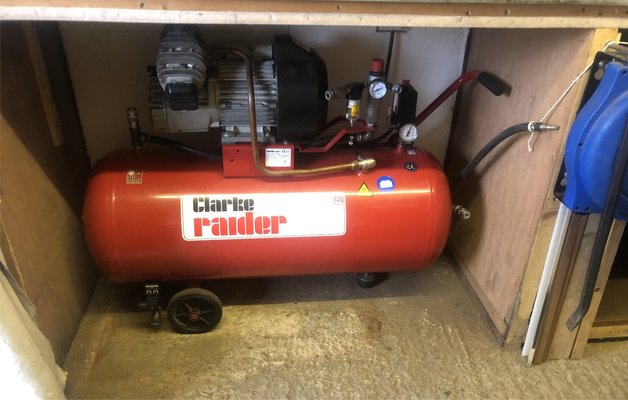
close up of the autodrain all connected and works great.
thanks everyone for the help with info and replys.
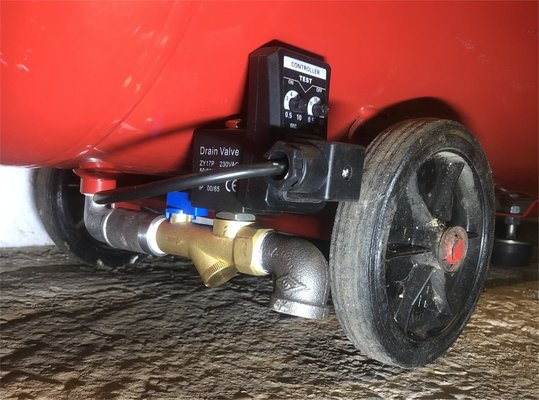
so the quick connectors arrived.
1/2bsp male, 3/8 bsp male
took the gate valve and water trap off the 1/2 elbow on tank right side.
the gate valve went from 1/2bsp to 1/4bsp and as that hose goes to a quick connector near the lathe for a air line
and thru the wall to a regulator/water trap for the shotblast cabinet.
i thought it best to do away with the 1/4 valve and water trap, and keep it as big bore as poss...
so now 1/2bsp elbow to a 1/2bsp male quick connector.
on the left side i changed the 3/8 elbow to a 3/8 tee.
to put an extra 3/8 male quick connector on that side.
so i can run a hose to a regulator on the left side for the plasma to be connected too.

close up of the autodrain all connected and works great.
thanks everyone for the help with info and replys.

T0rnado69
DIY nut !!
- Messages
- 1,901
- Location
- Essex
7 quid? Where did you get those,?Pretty much standard, they really are all the same, guarantee it will come in the same unmarked white box as all the others.
They are a good hustle sticking them on a service plan bought at £7 fitted for £150 charged out for annual servicing.
Consider a valve then a flange union then a short length of pipe makes getting it easier
James1979
Member
- Messages
- 8,418
- Location
- Orkney
liquid PTFEl
or is there something else i need to get to
T0rnado69
DIY nut !!
- Messages
- 1,901
- Location
- Essex
cheers il have a search.liquid PTFE
timgunn1962
Member
- Messages
- 367
- Location
- Lancashire UK
The liquid PTFE I use is the Flomasta one from Screwfix. It's cheap and it's boring: it just works. https://www.screwfix.com/p/flomasta-ptfe-liquid-50g/5321j
T0rnado69
DIY nut !!
- Messages
- 1,901
- Location
- Essex
ohh damm i was at screwfix yesturday lol typical..The liquid PTFE I use is the Flomasta one from Screwfix. It's cheap and it's boring: it just works. https://www.screwfix.com/p/flomasta-ptfe-liquid-50g/5321j
cheers timgunn, il swing by tomorrow on way out.
get this stuff instead of tape/liquid
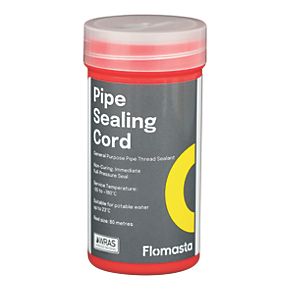
it's sealed up a few things for me that didn't want to seal
parralel threads into parralel threads?
where your made bit scres into the 90' see if you can fit a dowty washer https://www.ebay.co.uk/b/Dowty-Washers/48718/bn_7023437680
where it's brass into your fitting you don;t have much choice but lots of taspe/string.... unless you drop a spacer inside it, so it toucehss the faces of the 90' fitting and the brass fittings.... then put a wsheer on each side
so 90'c fitting, washer, spacer, washer, brass fitting
worth trying the string first tho

Flomasta Pipe Sealing Cord 80m
Order online at Screwfix.com. Nylon and silicone thread sealant for gas and water applications. Creates a non-curing, immediate full-pressure seal. For use with water up to 85°C. Ideal alternative to tape, hemp and pastes. FREE next day delivery available, free collection in 5 minutes.
www.screwfix.com
it's sealed up a few things for me that didn't want to seal
parralel threads into parralel threads?
where your made bit scres into the 90' see if you can fit a dowty washer https://www.ebay.co.uk/b/Dowty-Washers/48718/bn_7023437680
where it's brass into your fitting you don;t have much choice but lots of taspe/string.... unless you drop a spacer inside it, so it toucehss the faces of the 90' fitting and the brass fittings.... then put a wsheer on each side
so 90'c fitting, washer, spacer, washer, brass fitting
worth trying the string first tho
That f-f looks cockeyed /cross threaded.many joints are leaking.
some are tiny bubbles to this big one.
clearly ptfe tape aint doing the job.
so would thread lock be better?
or is there something else i need to get to make all the joints air tight.
cheers.
Normal Ptfe should be fine for connections like that. Why is that even there? Stick the brass valve straight into the elbow.


